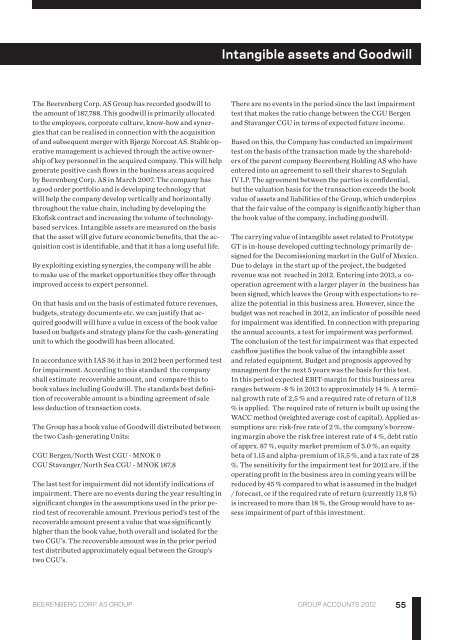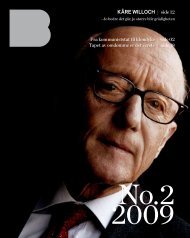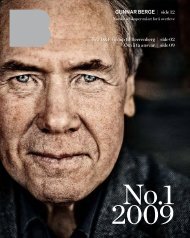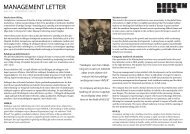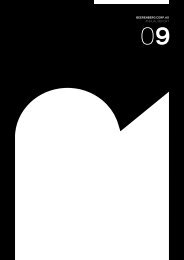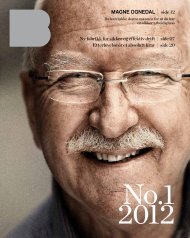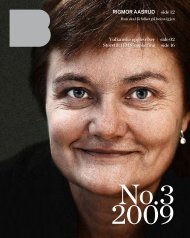Note 1 - Beerenberg
Note 1 - Beerenberg
Note 1 - Beerenberg
You also want an ePaper? Increase the reach of your titles
YUMPU automatically turns print PDFs into web optimized ePapers that Google loves.
Intangible assets and Goodwill<br />
The <strong>Beerenberg</strong> Corp. AS Group has recorded goodwill to<br />
the amount of 187,788. This goodwill is primarily allocated<br />
to the employees, corporate culture, know-how and synergies<br />
that can be realised in connection with the acquisition<br />
of and subsequent merger with Bjørge Norcoat AS. Stable operative<br />
management is achieved through the active ownership<br />
of key personnel in the acquired company. This will help<br />
generate positive cash flows in the business areas acquired<br />
by <strong>Beerenberg</strong> Corp. AS in March 2007. The company has<br />
a good order portfolio and is developing technology that<br />
will help the company develop vertically and horizontally<br />
throughout the value chain, including by developing the<br />
Ekofisk contract and increasing the volume of technologybased<br />
services. Intangible assets are measured on the basis<br />
that the asset will give future economic benefits, that the acquisition<br />
cost is identifiable, and that it has a long useful life.<br />
By exploiting existing synergies, the company will be able<br />
to make use of the market opportunities they offer through<br />
improved access to expert personnel.<br />
On that basis and on the basis of estimated future revenues,<br />
budgets, strategy documents etc. we can justify that acquired<br />
goodwill will have a value in excess of the book value<br />
based on budgets and strategy plans for the cash-generating<br />
unit to which the goodwill has been allocated.<br />
In accordance with IAS 36 it has in 2012 been performed test<br />
for impairment. According to this standard the company<br />
shall estimate recoverable amount, and compare this to<br />
book values including Goodwill. The standards best definition<br />
of recoverable amount is a binding agreement of sale<br />
less deduction of transaction costs.<br />
The Group has a book value of Goodwill distributed between<br />
the two Cash-generating Units:<br />
CGU Bergen/North West CGU - MNOK 0<br />
CGU Stavanger/North Sea CGU - MNOK 187,8<br />
The last test for impairment did not identify indications of<br />
impairment. There are no events during the year resulting in<br />
significant changes in the assumptions used in the prior period<br />
test of recoverable amount. Previous period’s test of the<br />
recoverable amount present a value that was significantly<br />
higher than the book value, both overall and isolated for the<br />
two CGU’s. The recoverable amount was in the prior period<br />
test distributed approximately equal between the Group’s<br />
two CGU’s.<br />
There are no events in the period since the last impairment<br />
test that makes the ratio change between the CGU Bergen<br />
and Stavanger CGU in terms of expected future income.<br />
Based on this, the Company has conducted an impairment<br />
test on the basis of the transaction made by the shareholders<br />
of the parent company <strong>Beerenberg</strong> Holding AS who have<br />
entered into an agreement to sell their shares to Segulah<br />
IV LP. The agreement between the parties is confidential,<br />
but the valuation basis for the transaction exceeds the book<br />
value of assets and liabilities of the Group, which underpins<br />
that the fair value of the company is significantly higher than<br />
the book value of the company, including goodwill.<br />
The carrying value of intangible asset related to Prototype<br />
GT is in-house developed cutting technology primarily designed<br />
for the Decomissioning market in the Gulf of Mexico.<br />
Due to delays in the start up of the project, the budgeted<br />
revenue was not reached in 2012. Entering into 2013, a cooperation<br />
agreement with a larger player in the business has<br />
been signed, which leaves the Group with expectations to realize<br />
the potential in this business area. However, since the<br />
budget was not reached in 2012, an indicator of possible need<br />
for impairment was identified. In connection with preparing<br />
the annual accounts, a test for impairment was performed.<br />
The conclusion of the test for impairment was that expected<br />
cashflow justifies the book value of the intangbible asset<br />
and related equipment. Budget and prognosis approved by<br />
managment for the next 5 years was the basis for this test.<br />
In this period expected EBIT-margin for this business area<br />
ranges between -8 % in 2013 to approximately 14 %. A terminal<br />
growth rate of 2,5 % and a required rate of return of 11,8<br />
% is applied. The required rate of return is built up using the<br />
WACC method (weighted average cost of capital). Applied assumptions<br />
are: risk-free rate of 2 %, the company’s borrowing<br />
margin above the risk free interest rate of 4 %, debt ratio<br />
of apprx. 87 %, equity market premium of 5.0 %, an equity<br />
beta of 1.15 and alpha-premium of 15,5 %, and a tax rate of 28<br />
%. The sensitivity for the impairment test for 2012 are, if the<br />
operating profit in the business area in coming years will be<br />
reduced by 45 % compared to what is assumed in the budget<br />
/ forecast, or if the required rate of return (currently 11,8 %)<br />
is increased to more than 18 %, the Group would have to assess<br />
impairment of part of this investment.<br />
<strong>Beerenberg</strong> CORP. AS Group group accounts 2012<br />
55


